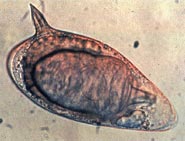This article needs additional citations for verification. (July 2016) |
Schistosoma is a genus of trematodes, commonly known as blood flukes. They are parasitic flatworms responsible for a highly significant group of infections in humans termed schistosomiasis, which is considered by the World Health Organization to be the second-most socioeconomically devastating parasitic disease (after malaria), with hundreds of millions infected worldwide.[1][2]
Adult flatworms parasitize blood capillaries of either the mesenteries or plexus of the bladder, depending on the infecting species. They are unique among trematodes and any other flatworms in that they are dioecious with distinct sexual dimorphism between male and female. Thousands of eggs are released and reach either the bladder or the intestine (according to the infecting species), and these are then excreted in urine or feces to fresh water. Larvae must then pass through an intermediate snail host before the next larval stage of the parasite emerges that can infect a new mammalian host by directly penetrating the skin.
- ^ "Schistosomiasis Fact Sheet". World Health Organization. Retrieved 10 August 2011.
- ^ "Schistosomiasis". Centers for Disease Control and Prevention. Retrieved 10 August 2011.
